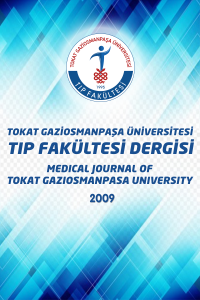IVF Uygulamalarında Embriyoların Kültür Ortamına Salgıladıkları HLA-G’nin İmplantasyon Oranlarına Etkisi
Giriş: Bu çalışma ile sHLA-G’nin, kaliteli embriyonun seçiminde bir ölçüt olup olamayacağını araştırmayı amaçladık. Gereç ve Yöntem: Çalışmamızda, değerlendirmeye alınan 38 hastadan elde edilen Folikül sıvısı, kan ve embriyo kültür medyasında sHLA-G konsantrasyonlarını ölçtük. Hasta grubunu, gebe kalanlar (n=15) ve kalmayanlar (n=23) olmak üzere 2 gruba, gebe kalanları da, görülen gebelik kesesi sayısı, 1 (n=5) ve 2 tane olanlar (n=10) olmak üzere iki gruba ayırdık. Bulgular: Hastaların, Folikül sıvısı ve kanlarındaki sHLA-G miktarı ile βhCG değerleri arasında bir korelasyon saptadık (sırasıyla r=0,357;p<0,05 ve r=0,730;p<0,05). Ancak, hastaları, gebe olanlar (aynı sırasıyla r=0,146;p>0,05 ve r=0,089;p>0,05) ve olmayanlar (aynı sıra ile r=0,284;p>0,05 ve r=0,366;p>0,05) diye ayırdığımızda iki grupta da bir korelasyonun olmadığını tespit ettik. Bir hastaya transfer edilen tüm embriyoların toplam sHLA-G değeri ile görülen gebelik kesesi sayısını karşılaştırdık ve aralarında bir korelasyon olduğunu tespit ettik (r=0,544; p<0,05). Gebe kalan hastaları, gebelik kesesi sayısına göre ayırarak oluşturduğumuz iki grubun karşılaştırılmasında da gruplar arasında anlamlıya oldukça yakın bir fark görüldü (=0,05). sHLA-G’nin etkisinin daha net görülebilmesi için, transfer edilen embriyolar sHLAG(+) ve sHLA-G(-) olarak işaretlenip karşılaştırıldığında ise sHLAG (+) embriyo sayısı arttıkça gebelik oranının arttığını gözlemledik. Sonuç: Embriyonun salgıladığı sHLA-G miktarı arttıkça implantasyon ihtimalinin arttığını düşünüyoruz. Ancak, sHLA-G miktarı yüksek olduğu halde gebelik elde edilmeyen hastaların olması, sHLA-G’nin önemli bir etken olduğunu ama tek başına etkili olmadığını düşündürmektedir.
Effect of HLA-G Secreted By Embryo In Culture Median on Implantation Rate in IVF
Introduction: One of the most important risk of IVF is multiple pregnancy. The studies that aim to prevent to multiple pregnancy based on the selection of the most quality embryo. We intended to research the potential of sHLA-G levels to be a criteria for prediction of embryo quality for in vitro fertilization. Material and Method: Concentration of sHLA-G in culture media, follicular fluid and blood samples obtained from 38 patients were analysed. The patient group were divided two group as not pregnant (n=23) and pregnant (n=15) that including separated into 2 groups the number of common gestational sac with one (n=5) and two (n=10). Results: We found a corelation between βhCG and that sHLA-G levels in Follicular Fluid and blood of patient (r=0.357;P<0.05 and r=0.730;P<0.05, respectively). But when we divided the patients as pregnant (r=0.146;P>0.05 and r=0.089;P>0.05) and non-pregnant (r=0.284;P>0.05 and r=0.366;P>0.05, respectively), we detected that there was no corelation between the two groups. When we compared the sHLA-G values of all transferred embryo and the number of common gestational sac and detected a corelation (r=0.544; P<0.05). This relationship was seen as near to meaningful in the comparison of the two group created to GCS (P=0.05). To make the corelation more clear, we marked transferred embryos as sHLA-G (+) and sHLA-G (-). Thus we detected that when the transferred sHLA-G (+) embryo number increased, also the rate of pregnacy increased, too. Conclusion: We thought that when the sHLA-G secrated by embryo increases, theimplantation ratio increase, too. But there are the non-pregnant patients who are transferred embryo which have high levels sHLA-G, it was thought that sHLA-G is important but is not sufficient alone for occuring of the pregnancy.
